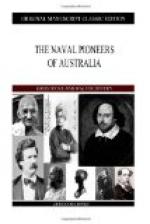“On the 18th day of September the captain and the master-pilot, taking with them ten men of Weybehays’ company, passed over in boats to the island of Cornelis. Those who still remained thereon lost all courage as soon as they saw them, and allowed themselves to be placed in irons.”
Pelsart remained another week at the Abrolhos, endeavouring to recover some of the Batavia’s treasure, and succeeded in finding all but one chest. The mutineers were tried by the officers of the Sardam, and all but two were executed before the ship left the scene of their awful crime. The two men who were not hanged were put on shore on the mainland, and were probably the first Europeans to end their lives upon the continent. Dutch vessels for many years afterwards sought for traces of the marooned seamen, but none were ever discovered.
The 1644 voyage of Tasman was made expressly for the purpose of exploring the north and north-western shores of the continent, and to prove the existence or otherwise of straits separating it from New Guinea. Tasman’s instructions show this, and prove that while the existence of the straits was suspected, and although Torres had unconsciously passed through them, they were not known. Tasman explored a long length of coast-line, establishing its continuity from the extreme north-western point (Arnhem Land) as far as the twenty-second degree of south latitude (Exmouth Gulf). He failed to prove the existence of Torres Straits, but to him, it is generally agreed, is due the discovery and naming of the Gulf of Carpentaria (Carpenter in Tasman’s time being President at Amsterdam of the Dutch East India Company) and the naming of a part of North Australia, as he had previously named the island to the south, after Van Diemen. From this voyage dates the name New Holland: the great stretch of coast-line embracing his discoveries became known to his countrymen as Hollandia Nova, a name which in its English form was adopted for the whole continent, and remained until it was succeeded by the more euphonious name of Australia. Tasman continued doing good service for the Dutch East India Company until his death at Batavia about 1659.
The last Dutch voyage which space permits us to mention [Sidenote: 1727] briefly is that of the Zeewigk, which ship was wrecked on the Abrolhos in 1727, with a quantity of treasure on board. Some of the crew built a sloop out of the wreck and made their way to Batavia, taking with them the bulk of the treasure; but from time to time, even down to the present century, relics of the wreck, including several coins, have been recovered, and are now to be seen in the museum of the West Australian capital. But before the Dutch had given up exploring the coast of New Holland, Dampier, the first Englishman to set foot upon its shores, had twice visited the continent, and with his two voyages the English naval story of Australia may properly begin.




